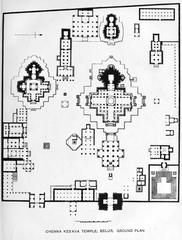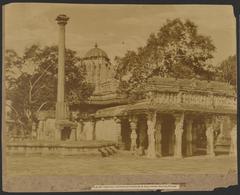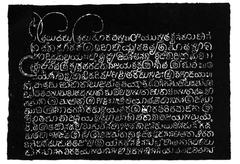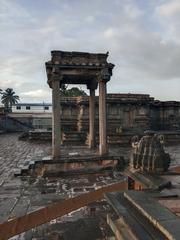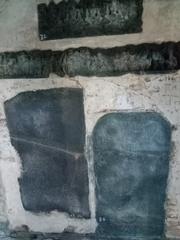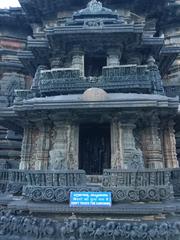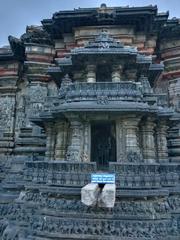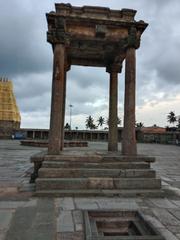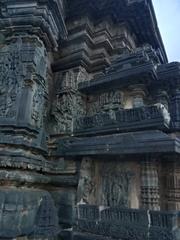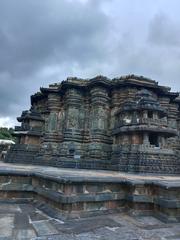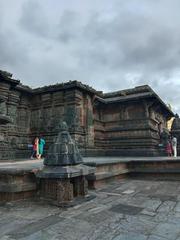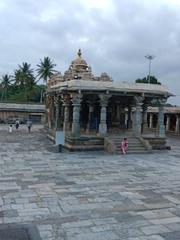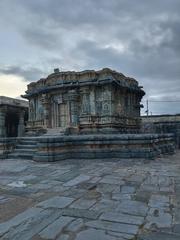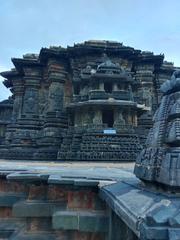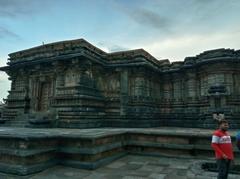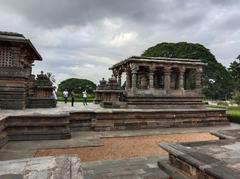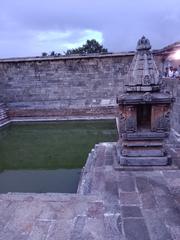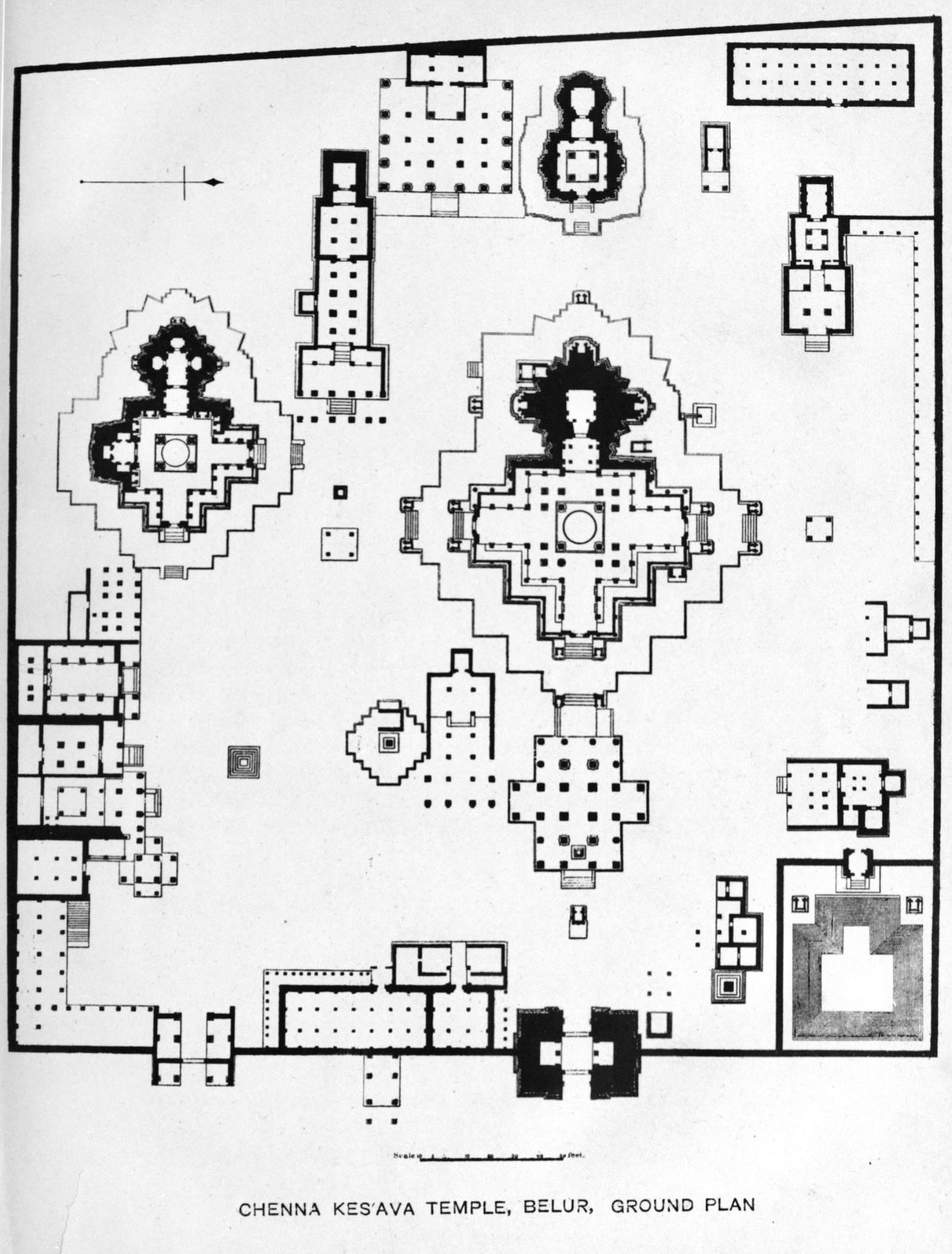
Chennakesava Temple Belur: Visiting Hours, Tickets, and Historical Significance
Date: 14/06/2025
Introduction
Nestled along the banks of the Yagachi River in Belur, Karnataka, the Chennakesava Temple stands as a testament to the artistic grandeur and spiritual devotion of the Hoysala dynasty. Commissioned in 1117 CE by King Vishnuvardhana to celebrate his victory over the Cholas and his conversion to Vaishnavism, this temple is renowned for its intricate soapstone carvings, star-shaped platform, and the celebrated madanikas (celestial dancer sculptures). More than an architectural marvel, Chennakesava Temple remains a vibrant center for cultural festivals, religious rituals, and historical exploration, attracting visitors from across the globe (Trawell.in; Inditales).
This guide provides essential details about visiting hours, ticketing, accessibility, travel tips, and the temple’s profound historical and cultural significance. Whether you are a history aficionado, architecture lover, or spiritual seeker, this article will help you plan a memorable visit to one of Karnataka’s most treasured monuments (TravelTriangle; Poojn.in).
Table of Contents
- Historical Background
- Visitor Information
- Key Features and What to See
- Festivals and Rituals
- Getting There and Nearby Attractions
- Travel Tips and Safety
- FAQ
- References
Historical Background
Origins and Foundation
The Chennakesava Temple was commissioned in 1117 CE by King Vishnuvardhana after his resounding victory over the Cholas at Talakad. This triumph not only shifted the power balance in South India but also marked the king’s conversion from Jainism to Vaishnavism, under the influence of Ramanujacharya. Belur, once the Hoysala capital, was chosen as the site for this grand monument to Lord Vishnu, known here as Chennakesava, meaning “handsome Keshava” (Trawell.in).
Construction and Artistic Flourishing
Constructed primarily from soapstone, the temple’s intricate design evolved over a century, reflecting contributions from multiple generations of rulers and artisans. The temple’s star-shaped platform allows for a circumambulatory path, and the main shrine houses a striking six-foot idol of Chennakesava. The 48 pillars in the main hall are each uniquely carved, with four central pillars featuring iconic madanikas, such as the “lady with a parrot” and the “huntress.” The complex also contains a stepwell (Pushkarani), subsidiary shrines, and a 42-meter Gravity Pillar, all exemplifying Hoysala architectural mastery (Inditales; Trawell.in).
Historical Challenges and Restoration
The temple endured invasions and plundering during the eras of the Delhi Sultanate and Deccan Sultanates. Despite periods of damage, extensive restoration efforts, especially in the Vijayanagara period and modern times, have preserved its grandeur. Ongoing conservation ensures the temple’s continued role as both a living place of worship and a significant heritage site (Viharadarshani).
Religious and Cultural Significance
Chennakesava Temple is a major Vaishnavite pilgrimage site and a repository of South Indian art. Festival celebrations such as Vaikunta Ekadashi and the annual Rathotsava (Chariot Festival) underscore its cultural vitality. Its sculptures narrate stories from the Ramayana, Mahabharata, and Puranas, while iconography within the temple also reflects Shaivite, Shakta, Jain, and Buddhist influences, symbolizing religious pluralism (Viharadarshani).
Visitor Information
Visiting Hours
- Daily: 9:00 AM to 5:30 PM
- Best Time: Early mornings and late afternoons offer cooler temperatures and softer lighting for photography.
- Note: Hours may vary during major festivals; confirm timings locally or via official sources (Poojn.in).
Tickets and Entry
- General Entry: Free for Indian citizens.
- Foreign Nationals: INR 500 (approximate; check for updates).
- Children below 15: Free.
- Guided Tours: Typically INR 500 for a 45-minute tour.
- Special Darshan: Nominal charges may apply; inquire at the temple office.
- Photography Permits: Required for professional equipment.
Dress Code and Etiquette
- Wear modest clothing covering shoulders and knees.
- Remove footwear before entering the temple complex; shoe racks are provided.
- Maintain silence in prayer areas and avoid touching sculptures.
- Follow all posted signs and respect the sanctity of the space.
Accessibility
- Ramps are available at key entry points for wheelchair users.
- Pathways and some areas have uneven stone flooring; assistance is available upon request at the ticket counter.
Guided Tours
- Local guides are available at the entrance, offering detailed insights into the temple’s history, architecture, and symbolism.
- Guided tours are highly recommended to appreciate the stories depicted in the temple’s carvings (SocialMaharaj).
Photography Policy
- Photography is permitted in outer areas, but not inside the sanctum.
- Flash photography and tripods may be restricted; always check with temple staff.
Key Features and What to See
Main Sanctum and Idol
The sanctum houses a six-foot idol of Chennakesava (Lord Vishnu), surrounded by a spacious mandapa supported by 48 ornately carved pillars, each telling its own story (TravelTriangle).
Madanikas and Pillars
The temple is famous for its 42 madanikas, bracket figures of celestial dancers, celebrated for their lifelike poses and intricate jewelry. Each of the four central pillars displays unique madanikas representing classical Indian dance forms (Travel.Earth; EDUCBA).
Gravity Pillar and Stepwell
The 42-meter-high Gravity Pillar (Garuda Stambha) stands in the courtyard, believed to be free-standing without a visible foundation. The Pushkarani (stepwell) near the entrance was historically used for ritual purification (Thrillophilia).
Subsidiary Shrines
Within the complex, smaller shrines such as the Kappe Chennigaraya Temple (built by Queen Shantala Devi), Sowmyanayaki Temple (dedicated to a form of Lakshmi), and Ranganayaki Temple offer additional architectural wonders (Travel.Earth; EDUCBA).
Temple Tank (Vishnu Samudra)
The temple tank, known as Vishnu Samudra, enhances the spiritual ambiance and continues to serve ritual purposes (Travel.Earth).
Festivals and Rituals
Chennakesava Temple is an active place of worship, hosting daily rituals such as Abhishekam and Alankaram. Major festivals include:
- Vaikunta Ekadashi: Special poojas and gatherings of devotees.
- Annual Rathotsava (Chariot Festival): A grand procession and cultural fair, typically held in March-April.
- Other Festivals: Brahmotsavam and Janmashtami, adding to the temple’s vibrant calendar (Inditales).
Participation in poojas can be booked at the temple office.
Getting There and Nearby Attractions
- Location: Belur, Hassan district, Karnataka. On the banks of the Yagachi River.
- By Road: 220 km from Bangalore, 155 km from Mysore, 25–30 km from Chikmagalur (TravelTriangle).
- By Rail: Hassan (40 km away) is the nearest railway station.
- By Air: Mangalore International Airport (170 km away).
- Transport: Buses and taxis connect Belur to major cities.
Nearby Attractions
- Hoysaleswara Temple, Halebidu: 16 km away, another Hoysala masterpiece.
- Veera Narayana Temple, Belavadi: 27 km from Belur.
- Chikmagalur: Renowned for coffee plantations and scenic landscapes.
A visit to Chennakesava Temple can be combined with these sites for a fulfilling cultural tour (TravelTriangle; Trawell.in).
Travel Tips and Safety
- Footwear: Remove shoes before entering.
- Dress Code: Wear modest clothing.
- Photography: Check for signage before clicking photos.
- Guides: Certified guides enhance your experience.
- Hydration: Carry water, especially in summer.
- Best Time: October to March for pleasant weather.
- Crowds: Visit during early mornings or late afternoons to avoid rush.
- Local Cuisine: Sample Karnataka dishes at Belur eateries.
- Responsible Tourism: Avoid touching sculptures and use designated bins for waste. Support local artisans by purchasing handicrafts from authorized vendors.
FAQ
Q: What are the Chennakesava Temple visiting hours?
A: 9:00 AM to 5:30 PM daily; timings may vary during festivals.
Q: Is there an entry fee?
A: General entry is free for Indian citizens; foreign nationals pay INR 500. Special darshan and guided tours may have nominal charges.
Q: Can I take photographs inside the temple?
A: Photography is allowed in outer areas but restricted inside the sanctum. Always follow posted rules.
Q: Is the temple accessible for differently-abled visitors?
A: Ramps are available at main entry points; some areas have uneven flooring.
Q: Are guided tours available?
A: Yes, local guides are available at the entrance for a fee, providing historical and architectural insights.
Q: What are the main festivals celebrated?
A: Vaikunta Ekadashi and the Annual Rathotsava are the principal festivals.
References
- Trawell.in
- Inditales
- Viharadarshani
- TravelTriangle
- Poojn.in
- SocialMaharaj
- Travel.Earth
- EDUCBA
- Thrillophilia
